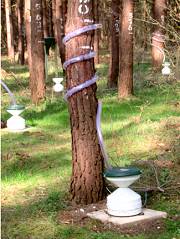Research
Research Status:completed
We use some essential cookies to make this website work.
We’d like to set additional cookies to understand how you use forestresearch.gov.uk, remember your settings and improve our services.
We also use cookies set by other sites to help us deliver content from their services.
A detailed study of rainfall passage and capture in the tree canopy

The forest canopy breaks up and captures rainfall, playing an important role in many hydrological, biogeochemical and ecological processes. Over the course of a year Forest Research collected detailed meteorological and precipitation data and characterised the canopy at two sites: an oak forest at Alice Holt and a Scots pine forest at Thetford. The team evaluated the suitability of Gash’s model – the most widely used model of canopy interception – to the short timescales required by modern ecosystem process models.

Example of hemispherical photographs for Oak (left) and Scots pine (right)
Available on request.
![]()
Part-funded by the EU Forest Focus ‘C’ scheme.
2006-2007
For details about the modelling component
For details of the instrumentation

Research Scientist
Cookies are files saved on your phone, tablet or computer when you visit a website.
We use cookies to store information about how you use the dwi.gov.uk website, such as the pages you visit.
Find out more about cookies on forestresearch.gov.uk
We use 3 types of cookie. You can choose which cookies you're happy for us to use.
These essential cookies do things like remember your progress through a form. They always need to be on.
We use Google Analytics to measure how you use the website so we can improve it based on user needs. Google Analytics sets cookies that store anonymised information about: how you got to the site the pages you visit on forestresearch.gov.uk and how long you spend on each page what you click on while you're visiting the site
Some forestresearch.gov.uk pages may contain content from other sites, like YouTube or Flickr, which may set their own cookies. These sites are sometimes called ‘third party’ services. This tells us how many people are seeing the content and whether it’s useful.